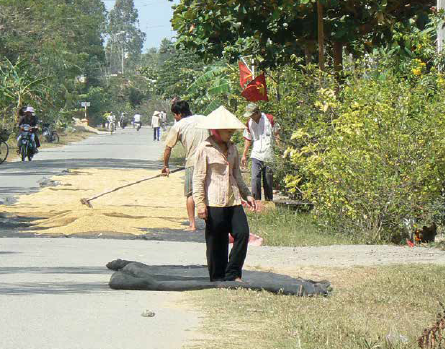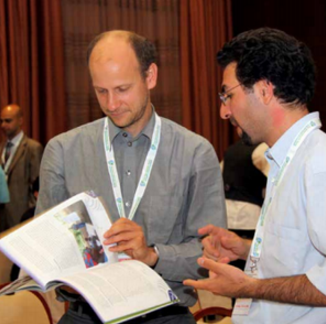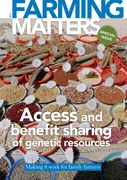Since 1991, François Meienberg has worked on access and benefit sharing (ABS), intellectual property rights and agriculture for the Berne Declaration. In this interview, Mr Meienberg reflects on the implementation of the ABS system so far. “We have to look for a kind of system which protects one kind of innovation without destroying the other.”
Could access and benefit sharing make farmer seed systems stronger?
One focus of the discussion on access is the International Treaty on Plant Genetic Resources for Food and Agriculture (ITPGRFA, see article Theory and practice) and its recognition of the right for farmers to save, exchange or sell farm saved seeds. However, if access is prohibited or restricted, for example by patents or breeders’ rights, farmers will not be able to develop or adapt the crop varieties that could help their communities survive in changing climate conditions.
Therefore it is mostly access that could strengthen farmer seed systems, even if there is no benefit sharing. It is crucial for the seed autonomy of farmers, as well as for national development, that access to seeds is guaranteed and not hindered by regulations or intellectual property issues. This is especially true in relation to climate change, since access to genetic resources is fundamental for the development of resilient varieties.
Could you say more about the challenges related to benefit sharing?
Nevertheless, there are some good examples of how the rather small amounts which have been distributed by the Benefit Sharing Fund so far have been supportive of farmer seed systems.
Examples include participatory plant breeding in Iran, the Potato Park in Peru and farmers’ breeding programmes in Southeast Asia. The goal of the ongoing revision is therefore to enhance the mandatory payments by users which, according to the Treaty ‘should flow primarily, directly and indirectly, to farmers in all countries, especially in developing countries, and countries with economies in transition, who conserve and sustainably utilise plant genetic resources for food and agriculture’.
What are your concrete proposals to improve the benefit sharing system for family farmers?

Photo: CBDC-BUCAP
If the goal is that benefits should be shared, in the sense that companies that use the genetic resources that have been developed by farmers will give something back to these farmers, then the benefit sharing system under the Treaty could be a thousand times simpler.
Under the current Standard Material Transfer Agreement (SMTA) and Treaty Art. 6.7, companies only share benefits when they commercialise a new variety that incorporates material accessed from the multilateral system and when the new variety derived from material supplied through the multilateral system is not freely accessible by other parties (companies, research centres) for further research and breeding due to intellectual property rights. Besides, even in the (not yet existing) case of a mandatory payment, it will occur only ten years after the initial access. But the accessed genetic resource has to be traced back through the whole breeding process in order to allow for benefit sharing.
The Berne Declaration, together with stakeholders from the Swiss seed sector, proposes that if companies want to have access to genetic resources under the multilateral system, which to a large extent have been developed by farmers, they should contribute a fixed benefit sharing payment on an annual basis. This could be a certain percentage of their annual seed sales, say 0.2%. Payments will be directed to the benefit sharing fund.
This access and payment system would be like a ‘library fee’, and be much less bureaucratic. There would be no need to trace the genetic contribution of the accessed genetic resources. This proposal could be seen as a further development of the current Art. 6.11 of the SMTA, which asks for payments of 0.5% of the sales of seeds belonging to the same crop as the genetic resource accessed under the MLS. If a party accesses a wheat variety, they will pay 0.5% of the wheat sales based on the resulting variety. Art 6.11 was introduced in the text of the SMTA at the end of negotiations in 2006 by the African delegation. It therefore is commonly referred to as the ‘African proposal’. Although users have the option to choose between payment modes either under Art. 6.7 of the SMTA or under Art. 6.11, nobody has chosen 6.11 so far. This shows that it is crucial that a revised benefit sharing system has only one payment modality. As long as there is also an option which allows for access without any obligation for benefit sharing, the option which effectively would implement mandatory payments will not be used.
It should be noted though, that the ‘library fee’ system does not represent a voluntary payment. Its advantage lies in the fact that it would avoid the task of monitoring the contribution of accessed varieties to the (ultimately) commercial marketing of varieties. It would certainly enhance the mandatory payments to the Benefit Sharing Fund.
How do formal and informal seed systems relate to each other?
The formal and informal seed sectors are interdependent. On the one hand, the Treaty, the Nagoya protocol and the overall ABS regime enable companies to access the pool of genetic resources developed by farmers. This is the biodiversity that is so crucial for further research and breeding. On the other hand, farmers need access to newly developed varieties in order to integrate the varieties into their informal seed systems and adapt them to the local needs and circumstances. This interdependency is often forgotten. We tend to think only about commercial breeders who need access to the gene pool developed by farmers in informal systems, for example, to help them develop varieties adapted to climate change. But there is also a need for farmers to access the formal seed systems on the basis of customary use, often for very similar purposes.
The Nagoya protocol makes an interesting point, stating that “Parties … shall, as far as possible, not restrict the customary use and exchange of genetic resources and associated traditional knowledge within and amongst indigenous and local communities in accordance with the objectives of the Convention.” To me, this proves that the Protocol recognises that farmer seed systems are important to promote biodiversity and that the Protocol could be used to support the rights of farmers to freely use, save, exchange and sell seeds.
Is monetary benefit sharing enough?

With regards to Farmers’ Rights, it is very important to mention that it is not enough to support farmers engaged in the conservation and sustainable use of genetic resources by the benefit sharing fund for the use of the genetic resources they developed. They especially need the legal space to use and further develop traditional knowledge and genetic resources. This is where the question of national seed laws comes in, which in some countries restrict the commercialisation of farmer seeds, or plant variety protection and patents which in many cases restrict or prohibit the use, exchange or sale of farm saved seed or other propagation material. This could have a negative impact on the further development of traditional knowledge, while at the same time depriving farmers of an essential tool to manage their seeds and ensure food security.
A good example of how plant variety protection should not develop is the 1991 revision of the International Convention for the Protection of New Varieties of Plants (UPOV ’91). UPOV does not take into account the interdependence of both the formal and informal systems. While UPOV ‘91 protects the innovations developed in the formal seed system, at the same time it destroys another innovation and seed system: the farmer seed system. This is why the Berne Declaration opposes its implementation. In summary, we have to look for a kind of system which protects one kind of innovation without destroying the other. Such a system should give access to both systems and allow all parties to access each other’s results.
Interview by Robin Pistorius
Between 2009 and 2012 Francois Meienberg acted as joint managing director for the Berne Declaration. To learn more, visit www.evb.ch


